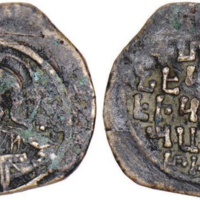Kiurike II Curopalatus - AE Follis - AC 514
Reference Description
Kiurike II Curopalatus 1048-1100
AE Follis
Obv. ՅՍ - ՔՍ
Bust of Christ facing, halo surrounds his head, face lightly bearded, holding Gospels, near his shoulders abbreviated inscriptions in armenian.
Rev. ՏՐ ՈԳ / ՆԷ ԿՈՐԻԿ / ԷԻ ԿՈՐԱ / ՊԱՂԱ / ՏԻՆ
(may the Lord aid Kiurike the Curopalatus)
Within circle five-lined Armenian inscription.
Ex.1 - 7.11g 27mm
Ex.2 - 6.76g 28mm
Ex.1 - Stack's The Golden Horn Collection 2009 lot 3467
Ex.2 - Roma Numismatics 8 lot 1199
AE Follis
Obv. ՅՍ - ՔՍ
Bust of Christ facing, halo surrounds his head, face lightly bearded, holding Gospels, near his shoulders abbreviated inscriptions in armenian.
Rev. ՏՐ ՈԳ / ՆԷ ԿՈՐԻԿ / ԷԻ ԿՈՐԱ / ՊԱՂԱ / ՏԻՆ
(may the Lord aid Kiurike the Curopalatus)
Within circle five-lined Armenian inscription.
Ex.1 - 7.11g 27mm
Ex.2 - 6.76g 28mm
Ex.1 - Stack's The Golden Horn Collection 2009 lot 3467
Ex.2 - Roma Numismatics 8 lot 1199
Notes
The importance of this unique issue of Armenian medieval coinage was eloquently summarized by David M. Lang in ANS Museum Notes VI in 1954: “…this is the earliest monetary issue to bear an inscription in Armenian, as well as being the only such type struck within Great Armenia in Transcaucasia before the transference of the kingdom to Little Armenia in Cilicia.” The obverse and reverse types imitate that of the anonymous folles of the Byzantine Emperor John I Tzimiskes (969-76 AD) and his successors, coins that would have been abundantly familiar in the Lori region of northern Armenian where the coins of Kiurike were issued, due to direct contact of Byzantium. In fact, according to Lang, the title Kouropalates was bestowed upon “the most prominent local dynasts on the fringes of the Byzantine empire [who] vied eagerly for the dignity of Kuropalates, the granting of which signified favour and recognition by the Byzantine court.” Lang believes this to have been an issue early in the reign of Kiurike II, between 1048 and 1064. In response to Lang’s argument for attribution to Kiurike II, Philip Grierson makes a strong argument in favor of Kiurike I (979-989), grandfather of Kiurike II.
Collection
Citation
“Kiurike II Curopalatus - AE Follis - AC 514,” Armenian Numismatic Research Organization, accessed January 22, 2025, https://armnumres.org/items/show/67.



